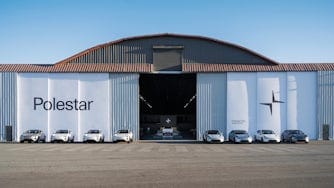Precept: Aerodynamics
The Precept describes our direction of travel, from technology to design. It is a vision of where we are heading, and aerodynamics will play a crucial role in that journey.

The aerodynamic profile of a vehicle can be tuned to improve handling, reduce noise and, of course, to improve efficiency. The more easily the car slips through the air, the less energy it takes to travel any given distance. For Precept that means more range for the same battery size and weight, a key factor.

“Precept is a car that was designed from the get-go with aerodynamics in mind. That is very evident when you look at things like the very low front or the aeroblades at the rear end” states Polestar Head of Design Maximilian Missoni.

The Precept features a front airduct that acts like a wing, integrated with the bonnet. This wing accelerates the air travelling underneath it and pulls the air stream down onto the car. This effect creates a more laminar flow, a term which describes extremely high efficiency. At the rear of the car aeroblades act to extend the bodywork. This longer "tail" reduces drag as air breaks from the car's surface. The Precept design was heavily inspired by aircraft, where, of course aerodynamics have been a focus since the dawn of flight.


